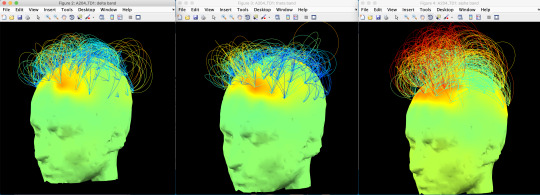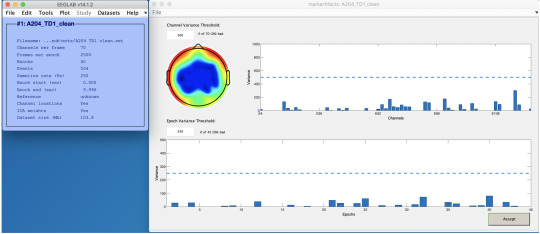Some things I've picked up over the years related to HD-EEG
Don't wanna be here? Send us removal request.
Text
Visualizing HD-EEG Data with the Mohawk Toolbox / App

One of the best visualizations of HD-EEG data is now available to everyone, thanks to the MOHAWK Matlab toolbox/app created and released by Srivas Chennu: https://www.cs.kent.ac.uk/people/staff/sc785/mohawk.html.
The MOHAWK toolbox utilizes free and powerful tools (ICA and machine learning) available in EEGLAB and Fieldtrip – and makes the process of cleaning HD-EEG data more standardized, faster, and easier to use than trying to run files through the individual toolboxes on your own. Most importantly, in the end it provides you with really amazing visualizations of spectral power and connectivity across the scalp, as a measure of consciousness and other brain states.
The toolbox requires you to have MATLAB, EEGLAB, and Fieldtrip installed, and it runs HD-EEG files from Philips Neuro (EGI) in MFF or RAW format. Installation of the MATLAB app is simple, and it’s available for free: https://github.com/srivaschennu/MOHAWK/wiki
The GitHub wiki site above also provides links to the papers published thus far that have used the analysis that Mohawk makes available in a seamless pipeline.
The basic steps that MOHAWK walks the user through are as follows (see images below):
· Load HD-EEG data (128 or 256 channels) in MFF or RAW format
· Downsample file to 250 Hz, filter 0.5-45 Hz, remove line noise
· Segment data into 10 second epochs, and remove baseline
· Popup: review, adjust as needed, and accept bad channel and epoch detection


Run ICA and review component waveforms and topomaps

Popup: review ICA corrected data in channel and epoch views

MOHAWK will then generate rotating visualizations of the delta, theta and alpha bands that can be saved as images or movies.

#hdeeg#consciousness#eeg#opensource#matlab#neuroscience#philips#philipsneuro bettersciencebettercare
0 notes
Text
Building an EEG Lab: Electrical and Acoustic Isolation
Below are some recommendations I’ve developed related to designing EEG acquisition spaces. By no means am I an expert in this area – this is a layperson’s guide. When in doubt, work with an electrician. All of the tools and products mentioned below are simply things that have worked for me.
Testing Electrical Grounding of Your Outlets
Working with an electrician or some tools and some web searching you can be sure the circuit you are powering your EEG equipment is grounded and not inducing noise in your data. The simplest test can be done with a receptacle tester that often are less than $10 (for example: https://tinyurl.com/yxtluhbl) or a multimeter (for example: https://tinyurl.com/MultiMeterTesters) or you can by a kit with multiple tools for as little as $35 (for example: https://tinyurl.com/ElectricToolKilt). If you discover that your outlet is not grounded, you should speak with your institutional electricians about installing a dedicated grounded circuit. If you have concerns about power outages or noise from the electrical system, try a continuous power supply that features a line conditioner.
Electrical Isolation
Faraday cages were once thought to be essential for EEG equipment but given that a majority of researchers will end up placing computers, speakers and other electronic equipment inside the shielded environment, a less expensive and potentially equally effective strategy is isolation. Electric fields drop off as a function of distance (http://www.emfs.info/what/distance/) so as long as the participant and equipment are a few feet away from a source you can expect minimal noise to contaminate the EEG. Try to limit or remove any non-essential equipment in the environment and minimize power supplies and looped cables near the participant or the amplifier.
Troubleshooting electrical noise sources can be difficult but an EMF meter can help locate sources so you can remove, distance, turn off or shield sources such as power cords and lighting. Not all EMF meters are created equal and have different levels of sensitivity that can make things more challenging. My favorite EMF meter is the TriField EMF Meter (Model TF2, $168, available at https://www.trifield.com/product/trifield-emf-meter/).
Sound Proofing / Acoustic Isolation
If you are building a new space or have funds to renovate a space for EEG acquisition, you can create a quiet space by using sound proof drywall such as Soundbreak XP or QuietRock. These two acoustic dry wall options can be twice as expensive as typical drywall but definitely make for a quiet room, particularly when used with soundproofing foam on top. Some labs use a double layer of acoustic drywall. It is best to not use insulation in walls as an air gap is better for attenuating sound. Again, if you have the walls open be sure to limit electrical wiring near your participant or EEG components that carry the signal to the amplifier.
I have used Sonex Foam (https://acousticalsolutions.com/product-category/acoustic-foam/) but imagine there are other brands available from many different suppliers. Depending on the size of the room, you can create a very quiet room for just a few hundred to a few thousand dollars. Often people forget to cover the ceiling with foam which can allow for a quite a bit of noise to enter even if you have acoustic ceiling tiles. Doors can also allow in quite a bit of noise if they are not
Recommendations for Developing an EEG Laboratory at a Primarily Undergraduate Institution. The Journal of Undergraduate Neuroscience Education (JUNE), Fall 2018, 17(1):A10-A19
http://www.funjournal.org/wp-content/uploads/2018/12/june-17-10.pdf?x91298
EEG Lab Design Guide- Department of Veteran Affairs - 2011
https://www.cfm.va.gov/til/dGuide/dgEEG.pdf
Setting Up and Running an ERP Lab
https://static1.squarespace.com/static/5abefa62d274cb16de90e935/t/5ac69f3d758d461c8c32ff66/1522966336221/Ch_16_Setting_Up.pdf
Setting Up A Lab: EGI / Philips Neuro Knowledge Center
https://www.egi.com/knowledge-center/setting-up-a-lab
0 notes
Text
EEGLAB Plugin for importing Philips Neuro/EGI HD-EEG Data
The plugin (MFFmatlabIO) is designed to allow Net Station files (EEG, physio channels; recorded in Net Station versions 4.5.7 to current release 5.4) to be seamlessly transferred from Net Station to EEGLAb without conversion or exporting. The plugin can be used with continuous, segmented and averaged data. You can take advantage of the core functionality of EEGLab as well as the countless data processing plugins available as add-ons from the web or the EEGLab plugin library. Another key feature of the plugin is the ability to export data from EEGLab back to MFF format for visualization and processing in Net Station.
Getting Started: Software Setup
If you have a Matlab license you’ll get better performance from EEGLAB but as of version 2.0 of the plugin, a Matlab license is not required -- see documentation related to Octave: https://sccn.ucsd.edu/wiki/Running_EEGLAB_on_Octave
Download EEGLAB: The plugin is currently compatible with version 14 and 15 of EEGLab. Version 15 is a developer’s release that is significantly faster than version 14 (the current stable release). The MFFmatlabIO plugin will be installed from within EEGLAB in a following step. ➢ Version 14 available at: https://sccn.ucsd.edu/eeglab/download.php ➢ Version 15 available at: https://github.com/eeglabdevelopers/eeglab
Start Matlab and EEGLAB. After starting Matlab, use the Matlab directory browser to go to the folder where you have uncompressed EEGLAB (many users place in the MATLAB folder in their documents folder). Make sure it is added to the Matlab path and then type “eeglab” and enter in the Matlab command line interface. The blue EEGLAB interface should pop up.
Install the MFFmatlabio EEGLAB extension. In the EEGLAB interface, select menu item “File > Manage EEGLAB extensions > Data import.” Select “MFFmatlabio” extension and press “OK.” This will download the extension and install it in EEGLAB.
Importing MFF Files into EEGLab and Exporting back to MFF
Import MFF file (mac) / folder (windows) Note: be sure to use the “Import Philips .mff file” plugin not the legacy simple binary, Matlab or seg functions. Only the Philips MFF plugin will allow you to import the full complexity of your data file (rich event information from E-Prime, channel locations, etc). There are three versions of MFF file formats – the plugin is designed to work with MFF version 3. For instructions on how to upgrade to version 3 from previous versions see page 39 of the Net Station 5 Manual (page 39) on the Philips Neuro / EGI website: www.egi.com.
Export back to MFF / Net Station at any point At any stage of processing in EEGLab you have the option to export from EEGLab back to Net Station using the File: Export Philips .mff file function.
EEGLAB Learning and Support For support related to EEGLab and/or any extensions or plugins other than the Philips Neuro plugin, please see the extensive online resources listed in the following section.
EEGLab Wiki: https://sccn.ucsd.edu/wiki/EEGLAB
Tips and FAQ: https://sccn.ucsd.edu/wiki/TIPS_and_FAQ
EEGLab Hardware and Software Recommendations: https://sccn.ucsd.edu/wiki/EEGLAB_hardware_and_software_recommendations
Online Workshop: https://sccn.ucsd.edu/wiki/Online_EEGLAB_Workshop
In Person Trainings: https://sccn.ucsd.edu/wiki/Future_workshops
Mailing List: https://sccn.ucsd.edu/wiki/EEGLAB_mailing_lists
1 note
·
View note
Text
Getting Started with EEG
I found the below articles and books very helpful in learning about EEG as a grad student. I often cite them in papers and recommend them to anyone interested learning more about electrophysiology. Many of them are open-access or freely available online with a Google Scholar search. Hopefully people find this useful! Let me know if there are others you think I should add.
The Basics:
Electrophysiology as a theoretical and methodological hub for the neural sciences
· https://tinyurl.com/y9dqxbqc
An introduction to the event-related potential technique.
· https://tinyurl.com/ycw2wd5y
The Oxford handbook of event-related potential components.
· https://tinyurl.com/ych9ff3q
Publication guidelines and recommendations for studies using electroencephalography and magnetoencephalography.
· https://tinyurl.com/ydah2tbf
The use of brain electrophysiology techniques to study language: A basic guide for the beginning consumer of electrophysiology information.
· https://tinyurl.com/yak6j5kh
EEG Data Acquisition, Data Quality and Experimental Design:
Recording and analyzing high-density event-related potentials with infants using the Geodesic Sensor Net
· https://tinyurl.com/y9xshtrj
Scalp electrode impedance, infection risk, and EEG data quality
· https://tinyurl.com/ybnzhjoh
EEG source localization: sensor density and head surface coverage
· https://tinyurl.com/yct2wqp3
Common Components, Oscillations and Effects
The mismatch negativity (MMN) in basic research of central auditory processing: a review.
· https://tinyurl.com/y8nhmnnd
Neuropsychology and neuropharmacology of P3a and P3b
· https://tinyurl.com/ybm77yd4
A cortical network for semantics:(de) constructing the N400.
· https://tinyurl.com/y89b29fb
1 note
·
View note